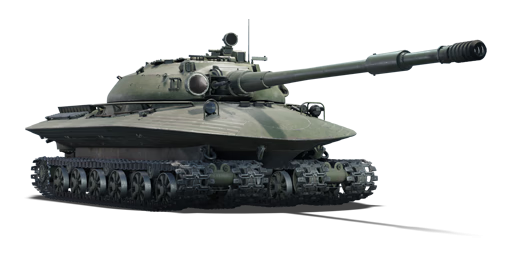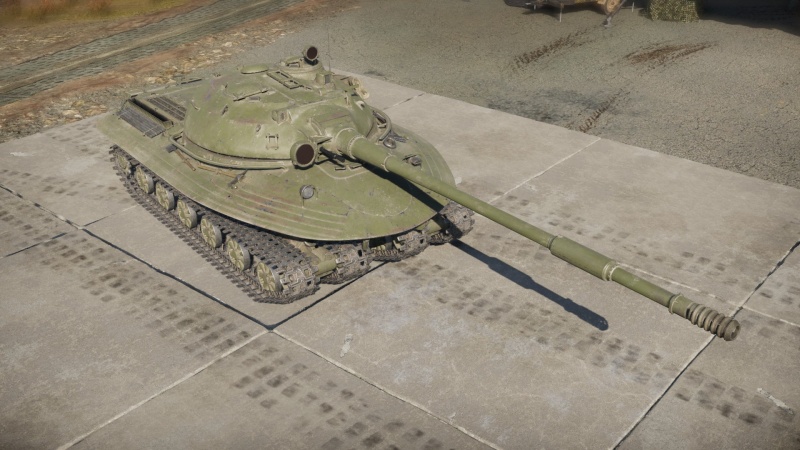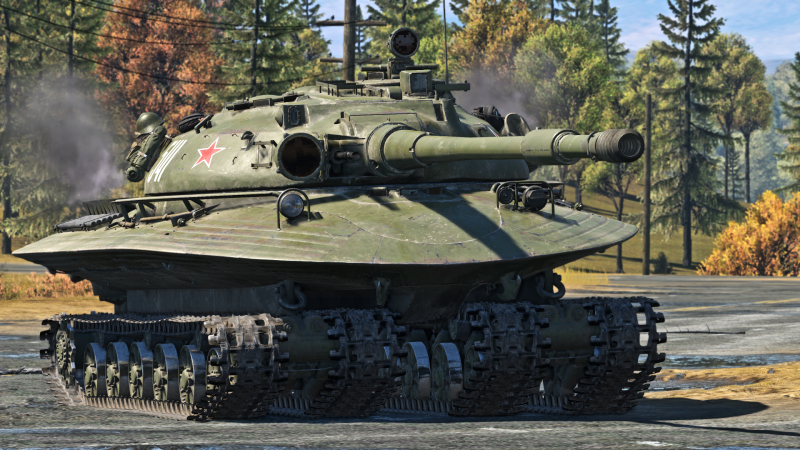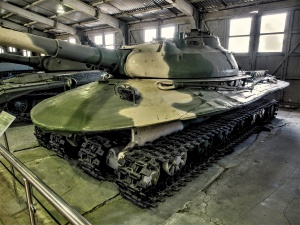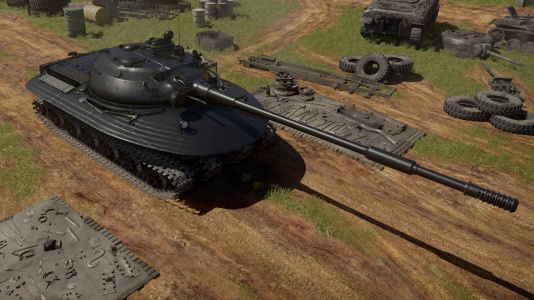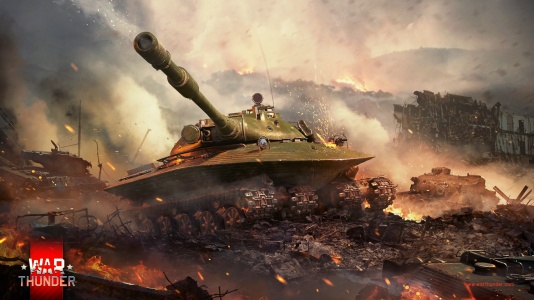Object 279
Contents
Description
The Object 279 is a gift rank VI Soviet heavy tank with a battle rating of 9.0 (AB/RB/SB). It was introduced during Update 1.97 "Viking Fury" as a reward for the "Space Race" event.
The Object 279's unique look comes with its design as being more capable of cross-country travelling in a possible nuclear warfare scenario. This produces its unique hull shape, four-track designs, and a large 130 mm cannon to deal with threats.
Upon release, Object 279 was nicknamed "Moon Rover" by the War Thunder Community.
General info
Survivability and armour
This tank is the peak of steel armour design, having its armour only consist of homogeneous steel armour. It is also arguably the most well-armoured heavy tank in the game. Getting the exact armour thickness of this tank is quite tricky due to the cast nature of its outer shell. But that won't affect the way one may view its survivability, at the very least the armour thickness of the hull may reach up to 300 mm when faced frontally (excluding the driver's hatch, which is 30 mm flat). The middle of the hull (area below the driver's hatch) is the least angled part of the tank besides the tank's rear, and thus is usually the first spot that is shot at, whereas the sides surrounding this area (left and right parts of the hull when faced front) can reach absurd amounts of thickness, even reaching up to 1000 mm due to extreme angles. However, this will not stop any APFSDS rounds, which are abundant at its BR. Most, if not all tanks at your BR can penetrate you from the front.
The turret is arguably the most armoured part of this tank. Again, getting the exact thickness is difficult but it is guaranteed to be very hard to penetrate, even APFSDS shells will have trouble going through certain spots of this tank. The only prominent weak spot of this turret is the mantlet and machine gun port on the left side of the gun when faced front. Going through the mantlet will more or less only break the gun breech in most cases. One usually shoots the rear side of the turret because that is where the ready rack is located.
It is important to mention the cramped crew spacing. It is like most, if not all, Soviet tank designs where the engineers threw the entire concept of crew comfort out the window. This is important when it comes to the survivability of the crew whenever a shell is able to punch through its stubborn shell. The crew spacing is quite cramped and thus more susceptible to shrapnel damage caused by spalling. On the bright side, most nations have given up on the concept of APHE shell at around this tank's BR so the chances of one-shots are reduced to a degree. Though there are unlucky times when a shell goes through the plate and hit the ready rack behind the gun breech.
Another feature worth mentioning on this vehicle are its self sealing fuel tanks located along the tracks of the tank. To the inexperienced player, these may be an appealing target but that is not recommended unless the intention was to interrupt a repair, most of the time this will only cause a fire and maybe break some tracks (causing a fire is pointless due to the self extinguishing feature). A more recommended target on the side is the bulge made to accommodate the size of the turret (this bulge is also present on the T-62), it is the flattest part of the tank, besides the rear.
All around, this tank is a very hard nut to crack but one should not rely on its armour to stop incoming projectiles. It shares at least some similarities with the T-10M and it has a similar playstyle.
Mobility
| Game Mode | Max Speed (km/h) | Weight (tons) | Engine power (horsepower) | Power-to-weight ratio (hp/ton) | |||
|---|---|---|---|---|---|---|---|
| Forward | Reverse | Stock | Upgraded | Stock | Upgraded | ||
| Arcade | 59 | 20 | 60.4 | 1,291 | 1,908 | 21.37 | 31.59 |
| Realistic | 56 | 18 | 884 | 1,000 | 14.64 | 16.56 | |
The mobility is good for a vehicle of its size and weight, with a -18 km/h reverse speed, meaning it can actually back out of situations. As a heavy tank, the turning capabilities remain sub-par and the Object 279 loses a lot of speed when turning.
Modifications and economy
Armaments
Main armament
The main armament is a powerful 130 mm gun. It has decent ballistics and, coupled with the rangefinder, HE filler, and penetration comparable to some APFSDS shells, it is an extremely effective main armament.
| 130 mm M-65 | Turret rotation speed (°/s) | Reloading rate (seconds) | |||||||||||
|---|---|---|---|---|---|---|---|---|---|---|---|---|---|
| Mode | Capacity | Vertical | Horizontal | Stabilizer | Stock | Upgraded | Full | Expert | Aced | Stock | Full | Expert | Aced |
| Arcade | 40 | -5°/+17° | ±180° | Two-plane | 14.56 | 20.16 | 24.48 | 27.07 | 28.80 | 11.18 | 9.89 | 9.12 | 8.60 |
| Realistic | 10.71 | 12.60 | 15.30 | 16.92 | 18.00 | ||||||||
Ammunition
| Penetration statistics | |||||||
|---|---|---|---|---|---|---|---|
| Ammunition | Type of warhead |
Penetration @ 0° Angle of Attack (mm) | |||||
| 10 m | 100 m | 500 m | 1,000 m | 1,500 m | 2,000 m | ||
| BR-482B | APCBC | 364 | 360 | 342 | 321 | 302 | 284 |
| OF-482M | HE | 37 | 37 | 37 | 37 | 37 | 37 |
| Shell details | |||||||||
|---|---|---|---|---|---|---|---|---|---|
| Ammunition | Type of warhead |
Velocity (m/s) |
Projectile Mass (kg) |
Fuse delay (m) |
Fuse sensitivity (mm) |
Explosive Mass (TNT equivalent) (g) |
Ricochet | ||
| 0% | 50% | 100% | |||||||
| BR-482B | APCBC | 1,000 | 33.4 | 1.2 | 19 | 192.5 | 48° | 63° | 71° |
| OF-482M | HE | 900 | 33.4 | N/A | 0.1 | 3,640 | 79° | 80° | 81° |
Ammo racks
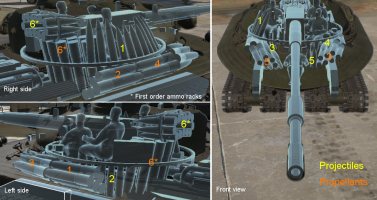
| Full ammo |
Ammo type |
1st rack empty |
2nd rack empty |
3rd rack empty |
4th rack empty |
5th rack empty |
6th rack empty |
Visual discrepancy |
|---|---|---|---|---|---|---|---|---|
| 40 | Projectiles Propellants |
31 (+9) 36 (+4) |
28 (+12) 31 (+9) |
19 (+21) 24 (+16) |
17 (+23) 19 (+21) |
14 (+26) 14 (+26) |
1 (+39) 1 (+39) |
No |
Notes:
- Projectiles and propellant bags are modeled individually and disappear after having been shot or loaded.
- Both racks 6 are first stage ammo racks for projectiles and propellant bags. They represent 13 shots and get filled first when loading up the tank.
- They are also emptied early: the rack depletion order at full capacity is: 6 - 1 - 2 until 5.
- Simply not firing when the gun is loaded will move ammo from racks 1-5 into racks 6. Firing will interrupt the restocking of the ready racks.
Machine guns
| 14.5 mm KPVT | ||||
|---|---|---|---|---|
| Mount | Capacity (Belt) | Fire rate | Vertical | Horizontal |
| Coaxial | 800 (50) | 600 | N/A | N/A |
The KPVT is an very effective machine gun, on par with certain autocannons in terms of penetration, and can easily shred lightly armoured vehicles or even the sides of certain MBTs thanks it its 45 mm of penetration. The muzzle velocity of the KPVT is almost the same as the main gun, meaning it can be used as an ranging machine gun.
Usage in battles
The Object 279 is in a position where its main gun can penetrate most things it faces, and the large HE filler guarantees a one shot. However, the hull is weak, unless you are in a full downtier, it should definitely not be relied on. The turret, on the other hand, is incredibly strong. The Object 279 plays quite well like a tank destroyer, using your 1,000 m/s APHE shell and strong turret armour to quickly peek and take pot-shots at enemy positions. This strategy is effective in uptiers. In a full downtier you can use it like a heavy tank, rushing caps and storming enemy positions, but HEATFS is abundant even at 7.7 and will end you fast.
Pros and cons
Pros:
- Great 130 mm gun; able to one-shot majority of the enemy tanks
- Main gun has a two-plane stabilizer
- Good overall mobility for its weight
- Access to rangefinder and NVD
- Coaxial 14.5 mm machine gun is great for dealing with light vehicles and aircraft
- Fuel tanks are self-sealing and will extinguish by themselves without incurring damage
- Extremely angled and thick cast armour
- Quick reloading speed for the size of the gun, first stage ammo consists of a 13 shell auto loader
- Can survive multiple hits from an ATGM frontally
- Turret is extraordinary though, even against modern sabot rounds
- Good reverse speed
- Secondary machine gun can act as a ranging MG
Cons:
- Inadequate turret traverse speed
- Inadequate depression angle, a feature shared by all Soviet tanks
- Vulnerable to high calibre HE; pylons connecting tank to tracks make for very appealing targets for such shells
- Most tanks at your BR can penetrate you from the front
- Very long main gun barrel can be a liability, allowing observant enemies to spot the tank hiding around corners
- Low muzzle velocity compared to APFSDS and APDS shells commonly found at this BR
- No laser rangefinder
History
Development
The Object 279 heavy tank was a combat vehicle intended to break through prepared defenses of the enemy in difficult terrain such as swamps, deep snow and vertical obstacles like boulders, hedgehogs, etc. Such cross-country capability was achieved through four tracks. It was developed between 1954 and 1960 jointly by OKBT LKZ and VNII-100 in Leningrad under the leadership of L. S. Troyanov. The presentation of the prototype for factory tests, as well as the hull and turret for firing tests, was planned for the last quarter of 1957 and the production of two machines by the second quarter of 1958.[1]
By March 1956, the preliminary design was prepared and the technical project by December of the same year, having a 1:1 size wooden mockup by the 30th of December. In the summer of 1957, two sets of hulls and turrets were manufactured, and their armour was tested by shelling at the NIIBT polygon. The technical project was finalized by November-December of 1957, having further increased armour protection. The deadlines for the new experimental vehicles were adjusted due to the large backlog of components needed, ending up in the last quarter of 1959 for the factory tests sample and second quarter of 1960 for the last two samples. The factory prototype passed the factory tests and drove for 502 km (with the engine running for 86 hours). The second prototype was successfully completed but the third prototype did not finish assembly. [1]
At the direction of GBTU alongside the government, the project was terminated in January 1961 with the first and third prototype being sent to the NIIBT landfill, and the second prototype left in storage at VNII-100.[1]
Design
The prototype of the tank had the classic layout scheme with a crew of four. To reduce the height of the hull, a diesel engine with a horizontal arrangement of cylinders was used and the driver was located in the recess between the tracks.[1]
Driver's Compartment
The driver's compartment featured the driver's seat, a control panel, mechanisms for driving the vehicle, two compressed air cylinders to start the engine, carbon dioxide cylinders for the fire protection system, and water pumps. Three TNPU-185A1 viewing devices were installed above the driver's seat on the roof of the hull where the entrance hatch is located. At the bottom of the hull, there was an emergency escape hatch behind the driver's seat. For driving at night, TVN-2T "Urol" night viewing device was mounted instead of the TNPU-185A1.[1]
Fighting Compartment
The fighting compartment of the tank occupied the middle of the hull and turret. It housed the main gun and coaxial weapons, automatic stabilization and guidance system "Groza-I", rangefinder sights, "Luna-II" night vision sight, radio station, tank intercom, gunner and commander seats to the left of the gun, one behind the other, and loader seat to the right of the gun. In the aft part of the compartment, there was an autoloader for 13 shots. For the convenience of the crew, a rotating floor was installed with a diameter of 1830 mm.[1]
To keep the fighting compartment clean from any fumes and powder gases during firing, a supercharger fan of the PAZ filter system was installed in the turret, creating an overpressure of 98-147 Pa. While the engine was not running and the gate valve was open, gases were removed through the air intakes, if the engine was running, they first entered the air purifier, into the engine, and ejected alongside the exhaust gases. The compartment was heated at low ambient temperatures by purified and heated air discharged from the engine supercharger through special pipes, which had shut-off valves that provided temperature regulation by adjusting the amount of heated air that was supplied.[1]
Turret
On the roof of the turret above the commander's station, there was a cupola with five TNPA viewing devices and a central TPKU, with vertical viewing angles of -5 to +17 degrees, which could be replaced with a night vision TKN-1T "Uzor" device. The commander's cupola design was borrowed from the Object 278 heavy experimental tank. To illuminate terrain and targets, an OU-3 infrared illuminator was used. To clean the TPKU sight, a mechanical cleaner "Dvorink" was provided. Lastly, the commander could take over the turret rotation horizontally only, there was no vertical targeting designation. The gunner had a TNPU-185A1 device installed in the roof of the turret, allowing him a forward and left view. For the convenience of using the viewing devices, the commander's seat had height and direction adjustment, the gunner's seat was mounted on the rotating floor and had height adjustment only while the loader's seat was mounted on the upper part of the turret. All seats had soft cushions and could be folded and reclined. To enter and exit the vehicle, the gunner and commander used the commander's cupola hatch, 618 mm in diameter, and the loader used his hatch, 530mm in diameter.[1]
Engine and Transmission Compartment
The engine and transmission compartment was located in the rear part of the hull, separated by the fighting compartment with a seal. The engine was mounted along the middle of the chassis right behind the compartment, the ejectors, water and oil radiators were installed on both sides of the engine, the oil tank was located on the front left, and the air purifiers and heating system were in front of the engine. The heater boiler and water pump were installed below the fighting compartment floor, with a removable sheet for ease of access to the pump. The fuel tanks were outside the hull itself and were located inside two beams in the undercarriage reducing the fire hazard of the tank and allowing for the ammunition to be placed in the hull.[1]
Firepower
The main weapon of the tank was a 130 mm M-65 rifled cannon equipped with a slit muzzle brake, an ejection device for purging the barrel after firing and an autoloader. A 14,5 mm KPVT machine gun was paired with the cannon, which could be used to help with the targeting. The armament complex featured an electrohydraulic two-plane stabilizer "Groza-I", optical periscope binocular sight rangefinder TPDS-36A (the third prototype used a vertically stabilized TPD2S rangefinder), and the night scope TPN-1 "Luna-II", used alongside the L-2 infrared searchlight. [1]
Sights
The TPDS-36A had an x8 magnification (9 degrees field of view, the rangefinder had 2 degrees) which could measure the range to the target from 1000 m to 4000 m. The aiming of the weapons could be carried out by the gunner from the remote control of the sight-rangefinder or the manual mechanisms for lifting the gun and turning the turret. The vertical aiming angles ranged from -5 degrees to +17 degrees 30 minutes and were limited by elastic stops, meaning the dead zone in front of the tank was 22,8 m. The TPN-1 night sight featured an x5 magnification (4 degrees field of view) and was installed on the roof of the tower, with the eyepiece located 170 mm above the TPDS, which had a removable sliding door to protect the optics from sunlight exposure and sharp flashes. Cleaning said eyepiece from dust and dirt was carried out with compressed air with a nozzle attached above the head of the sight.[1]
Stabilizer
The "Groza-I" stabilized provided gun aiming speeds between 0.005-4.5 degrees per second in the vertical plane and 0.005-18 degrees per second in the horizontal. Vertical guidance was carried out by two power cylinders and to the right of the gun, a power control cylinder which carried out the stabilizing of the gun was located. To the left of the gun, a braking power cylinder was installed to brake and lock the gun when moving it to extreme angles, and when loading and firing. On the body of the braking cylinder, a hydraulic pump and a gearbox were attached for manual guidance. Horizontal guidance could be carried out with both the "Groza-I" stabilizer and a manual hydraulic drive. Switching the horizontal guidance from manual to motor was carried out by the commander by switching a hydraulic lever, which was inconvenient during the vehicle's movement, manual rotation of the turret achieved a maximum of 4 degrees per second. As already noted previously, the commander could take over the horizontal rotation using his target designation control panel. A major disadvantage of the stabilizer was that it did not prevent blocking of the driver's hatch in automatic mode which could lead to the failure of opening said hatch.[1]
Loading Mechanism
The ammunition of the gun consisted of 40 two-piece shots with partially burning sleeves (normal loadout used 34 AP and 6 HE shots), of which 13 were in the autoloader. The autoloader consisted of a mechanized ammo stowage (conveyor belt that moved the shells and another conveyor for the cartridges, feeding them to the loading lift), a pneumatic lift and tray, and a dispenser. Each conveyor was an endless chain of 13 links, each link having a projectile/charge in special grips. All the links were unified which ensured the loading of shells into the conveyor in any combination of AP or HE shells. The rotation of the conveyor happened clockwise and in case of electromechanical failures, manual backup drives were used. To lift the sleeve and lower the tray during loading, pneumatic actuators were used powered by a common air system, which consisted of an air cylinder with a 5-liter capacity and a maximum pressure of 14,7 MPa, located in the back of the sleeve conveyor. The loading of the projectile and cartridge was carried out by the chain dispenser, located on the back of the turret behind the shell conveyor, made similarly to the D-25TA dispenser. The projectile was sent into the gun chamber first automatically and for the cartridge, the loader had to roll the supplied sleeve onto the tray and press the loading button on his control panel. The loading of the gun was carried out at an angle of 0 degrees +30 minutes. When the loading angle was reached, a light signal that allowed loading was turned on for the commander and loader. The loader could pick, to the commander's decision, the type of projectile and cartridge case using the control panel. After sending the sleeve, closing the breach and returning the tray to the starting position, the gun was automatically removed from the stopper and moved to the position that matched the sight. The combat rate of fire when using the autoloader reached 6-7 rounds/min.[1]Media
- Skins
- Images
- Videos
See also
Links to the articles on the War Thunder Wiki that you think will be useful for the reader, for example:
- reference to the series of the vehicles;
- links to approximate analogues of other nations and research trees.
External links
References
| Leningrad Kirov Plant (Ленинградский Кировский Завод) | |
|---|---|
| Medium Tanks | |
| T-28 | T-28 (1938) · T-28 · T-28E |
| T-80 | T-80B · T-80U · T-80UK · T-80BVM |
| Heavy Tanks | |
| KV-1 | KV-1 (L-11) · KV-1 (ZiS-5) · KV-1E · KV-1S |
| KV-2 | KV-2 (1939) · KV-2 (1940) · KV-2 (ZiS-6) |
| Other | SMK · KV-220 · IS-7 · Object 279 |
| Captured | |
| KV | ▀KV-IB · ▀KW I C 756 (r) · ▀KW II 754 (r) |
| Other | T-28 (Sweden) |
| Export | T-80U (Sweden) |
| See Also | Chelyabinsk Tractor Plant |
| USSR heavy tanks | |
|---|---|
| KV-1 | KV-1 (L-11) · KV-1 (ZiS-5) · KV-1E · KV-1S |
| KV-2 | KV-2 (1939) · KV-2 (1940) · KV-2 (ZiS-6) |
| Other KVs | KV-85 · KV-122 · KV-220 |
| IS-1/2 | IS-1 · IS-2 · IS-2 (1944) · IS-2 No.321 · IS-2 "Revenge" · Object 248 |
| Other IS tanks | IS-3 · IS-4M · IS-6 · IS-7 |
| T-10 | T-10A · T-10M |
| Multi-turreted | T-35 · SMK |
| Other | Object 279 |
| Lend-Lease | ▂MK-II "Matilda" |


